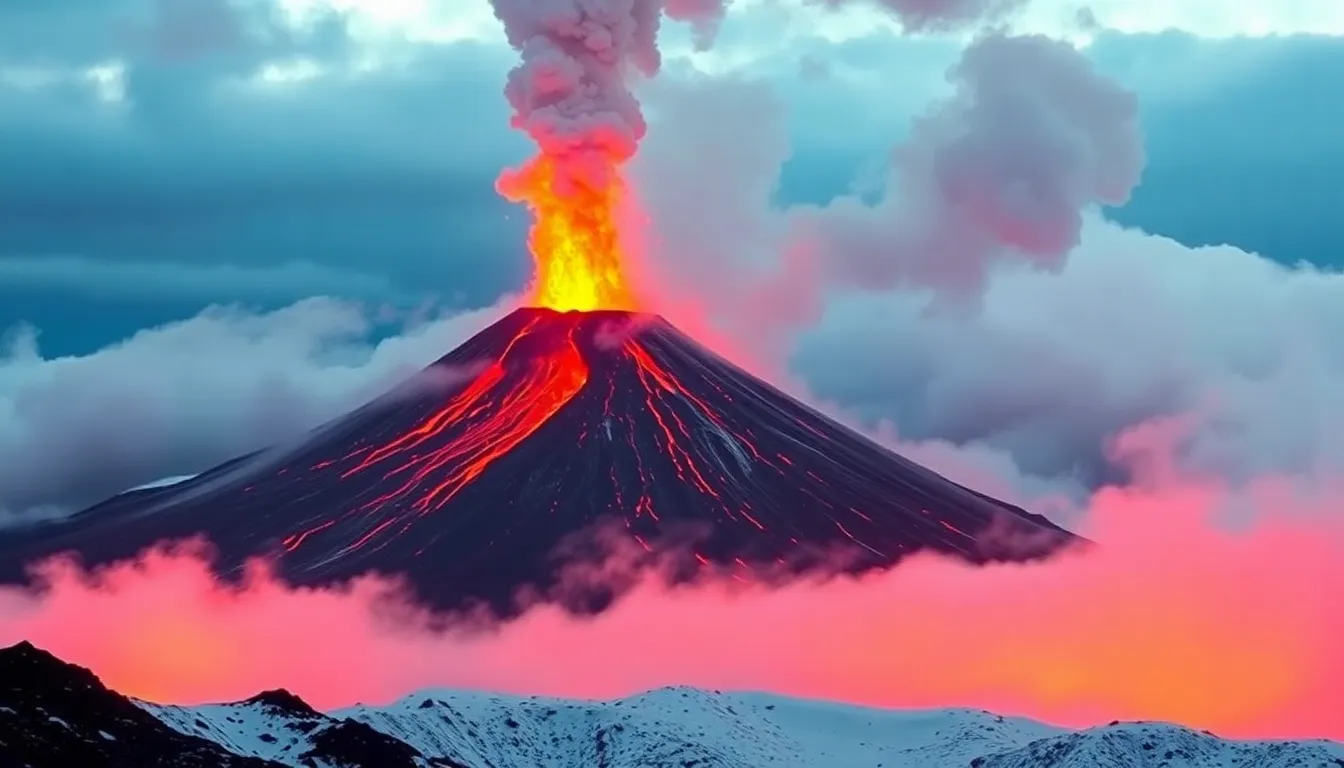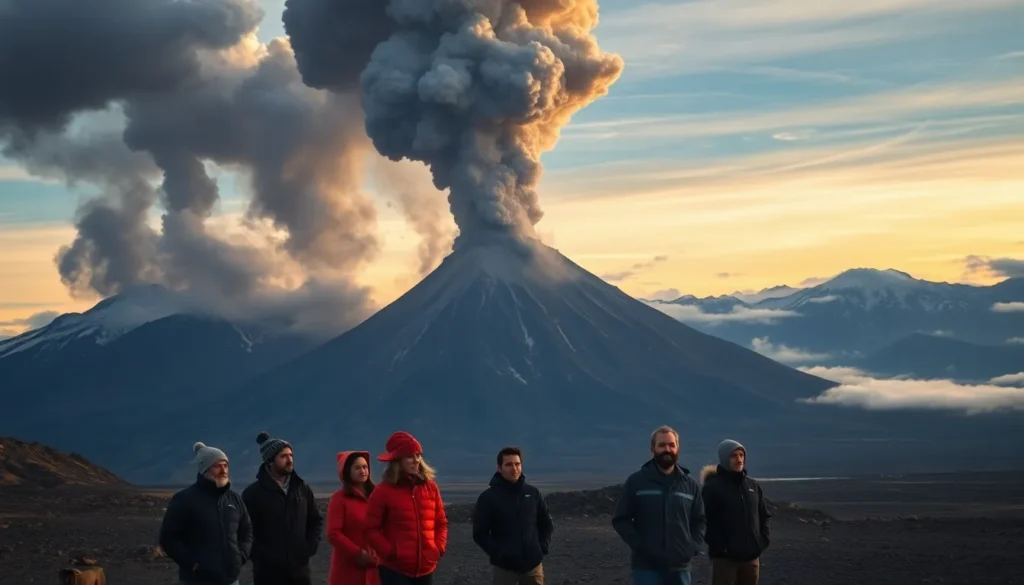Table of Contents
ToggleA powerful volcano erupted in Alaska yesterday, sending ash plumes high into the sky and capturing the attention of geologists and residents alike. This sudden event highlights the dynamic nature of the Alaskan landscape and the potential dangers posed by its active volcanoes.
As the eruption unfolded, local communities braced for impact, while scientists rushed to monitor the situation. The eruption serves as a reminder of the region’s volcanic activity and its implications for air travel, wildlife, and the environment. With Alaska being home to some of the most active volcanoes in the world, understanding these phenomena becomes crucial for preparedness and safety.
Overview of the Volcano Eruption in Alaska Yesterday
The volcanic eruption in Alaska yesterday occurred at the Alaska Peninsula’s Semisopochnoi volcano. This eruption generated significant ash plumes reaching altitudes of 20,000 feet. The U.S. Geological Survey (USGS) classified the event as moderate but noted the potential for increased activity.
Local residents observed ashfall in nearby communities, disrupting daily life. Authorities issued immediate advisories cautioning against outdoor activities due to air quality concerns. The National Park Service activated emergency protocols to ensure visitor safety in the affected areas.
Scientists continue to monitor the volcano’s behavior closely. Seismic activity indicated fluctuations in eruptive intensity. Continuous satellite imagery helps track ash dispersion, assisting air traffic control in refining flight paths. Understanding these changes remains critical for minimizing risk to wildlife and infrastructure.
Key measures implemented include:
- Monitoring Equipment: Enhanced sensor networks provide real-time data on volcanic gases and seismic activity.
- Public Alerts: Local agencies disseminate timely updates through multiple communication channels.
- Community Preparedness: Evacuation plans are reviewed regularly to ensure readiness for further eruptions.
The eruption’s impact on air travel is immediate. Flights to and from the region faced delays and cancellations. Airlines actively reroute planes to maintain passenger safety while monitoring volcanic conditions.
This eruption underscores Alaska’s unique geological activity. Volcanology experts emphasize the need for ongoing research to predict future eruptions more accurately. Understanding the dynamics of this eruption will aid in assessing risks and developing strategies for effective response and recovery.
Cause of the Eruption

The recent eruption at Semisopochnoi volcano stems from a combination of geologic and environmental factors. Understanding these influences is essential for assessing the eruption’s implications.
Geologic Factors
Geologic activity often drives volcanic eruptions. The Semisopochnoi volcano sits on the Aleutian Arc, where the Pacific Plate subducts beneath the North American Plate. These tectonic movements generate magma, causing pressure to build within the volcano’s chamber. As magma rises, gases escape, leading to increased pressure and eventual eruption. Recent seismic data indicate a significant increase in tremors, correlating with this magma movement and indicating that volcanic activity may persist.
Environmental Conditions
Environmental conditions also play a crucial role in eruption dynamics. Over the previous weeks, increased snowmelt from warmer temperatures heightened volcanic activity. This melting can lead to changes in pressure and lead to the destabilization of lava flows, which can result in explosive eruptions. Ashfall from the eruption poses significant hazards, such as air quality deterioration, impacting both local communities and wildlife. Monitoring weather patterns assists researchers in predicting potential changes in volcanic behavior and helps guide public safety advisories.
Impact on Local Communities
The recent eruption at the Semisopochnoi volcano has significantly affected local communities. Communities face immediate challenges from ashfall and reduced air quality, and longer-term considerations have emerged as residents adapt to ongoing volcanic activity.
Immediate Effects
Ashfall disrupted daily activities, leading to school closures and limited outdoor access. Residents reported respiratory issues due to airborne ash particles, prompting healthcare providers to increase support for at-risk individuals. Authorities implemented emergency measures, restricting outdoor activities and advising residents to stay indoors. Additionally, transportation faced severe disruptions, with flight cancellations and delays impacting travel plans for both residents and tourists. The National Park Service stationed teams to monitor environmental conditions and offer assistance to affected communities.
Long-Term Considerations
Communities must prepare for potential recurring eruptions and their associated risks. Continuous volcanic activity can lead to significant environmental changes, affecting local ecosystems and agriculture. Schools and local governments are revising emergency preparedness plans to address possible evacuation scenarios. Infrastructure improvements, such as enhanced ash removal systems, are being prioritized to mitigate future disruptions. Additionally, residents may need to invest in protective measures for homes and vehicles to reduce ash-related damage. Ongoing education about volcanic hazards is essential to ensure community members remain informed and prepared for future events.
Response from Authorities
Authorities have quickly mobilized in response to the recent eruption at the Semisopochnoi volcano. Coordination among various agencies aims to ensure community safety and minimize disruption.
Emergency Services Involved
Emergency services such as the Alaska Emergency Management Agency, local fire departments, and health officials are actively engaged. Coordinated efforts include monitoring air quality, assessing the impact of ashfall, and addressing health concerns related to respiratory issues. The Red Cross has also been activated to provide shelter and resources for displaced residents. Regular updates from the U.S. Geological Survey (USGS) keep the public informed about volcanic activity.
Evacuation Procedures
Evacuation procedures follow established protocols outlined in community emergency response plans. Authorities advise residents in high-risk areas to prepare for potential evacuations, particularly if volcanic activity escalates. Designated evacuation routes and shelters have been identified to facilitate safe exits. Public messaging emphasizes the importance of staying informed through local news and official channels to ensure timely action if evacuations are necessary. Regular drills are conducted to keep communities prepared for rapid response in future emergencies.
Scientific Significance
The recent eruption at Semisopochnoi volcano offers critical insights into volcanic behavior and tectonic processes. Monitoring this event provides valuable data on ash dispersion, which impacts air quality, climate models, and aviation safety. Researchers utilize advanced satellite technology to track ash plumes, helping to predict their trajectory and effects on surrounding ecosystems.
Seismic activity during this eruption reveals essential patterns in magma movement. The U.S. Geological Survey (USGS) identifies real-time fluctuations in tremors, indicating ongoing geological processes that may signal future eruptions. Analyzing these patterns informs scientific understanding of the interactions between tectonic plates in the Aleutian Arc, enhancing models that predict volcanic activity.
The eruption’s environmental factors, including increased snowmelt and warmer temperatures, highlight the interplay between climate change and volcanic dynamics. These factors may lead to more explosive eruptions in the future, underscoring the necessity for continuous research in volcanic systems.
The local ashfall’s effects on wildlife and vegetation are significant. Ash can alter soil composition and potentially impact nutrient cycling within ecosystems. Understanding these ecological impacts aids in developing strategies for habitat restoration post-eruption.
The coordinated response from agencies illustrates the importance of interdisciplinary collaboration in emergency management. Ongoing research supports enhanced community preparedness, particularly in vulnerable populations, by integrating scientific findings into public safety advisories.
The scientific significance of the Alaska eruption extends across multiple disciplines, contributing to geological knowledge, environmental health, and community resilience.
The recent eruption at Semisopochnoi volcano serves as a stark reminder of nature’s power and unpredictability. As local communities navigate the challenges posed by ashfall and disrupted daily life, the coordinated efforts of emergency services and scientific monitoring play a crucial role in ensuring safety.
The ongoing research into volcanic activity not only enhances public safety but also contributes to a deeper understanding of geological processes. The interplay between climate change and volcanic eruptions raises important questions about future risks.
As authorities continue to monitor the situation, the resilience of affected communities will be tested, emphasizing the need for preparedness and adaptability in the face of natural disasters.







